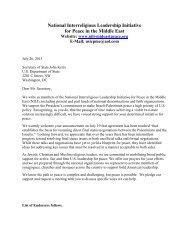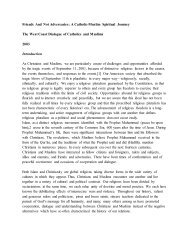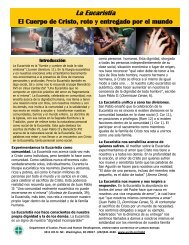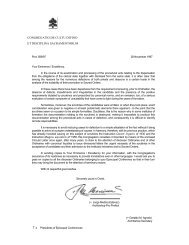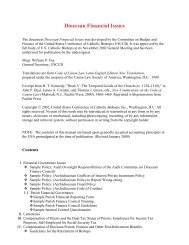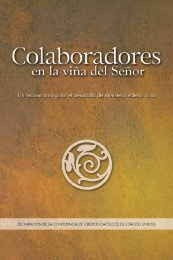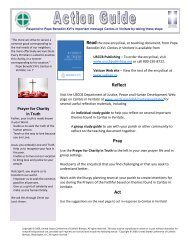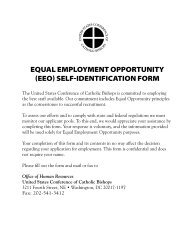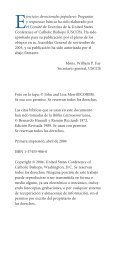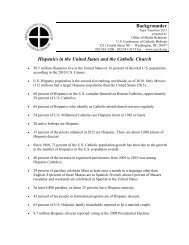Doctrinal Elements of a Curriculum Framework for the Development ...
Doctrinal Elements of a Curriculum Framework for the Development ...
Doctrinal Elements of a Curriculum Framework for the Development ...
- No tags were found...
You also want an ePaper? Increase the reach of your titles
YUMPU automatically turns print PDFs into web optimized ePapers that Google loves.
ElectivesOption A: Sacred ScriptureThe purpose <strong>of</strong> this course is to give an overview <strong>of</strong> Sacred Scripture with an introduction to <strong>the</strong> basic principles <strong>for</strong> understandingand interpreting <strong>the</strong> Bible. Because <strong>of</strong> <strong>the</strong> extent <strong>of</strong> <strong>the</strong> scriptural material, this outline will not try to cover <strong>the</strong>vast content but ra<strong>the</strong>r <strong>of</strong>fer comments about Scripture’s purpose and religious significance. Given <strong>the</strong> limits <strong>of</strong> a semester<strong>of</strong> study, it will not be possible to introduce all <strong>the</strong> books <strong>of</strong> <strong>the</strong> Bible here. But every ef<strong>for</strong>t is made to project a sense <strong>of</strong> <strong>the</strong> unity <strong>of</strong><strong>the</strong> narrative <strong>for</strong> <strong>the</strong> divine plan <strong>of</strong> salvation, <strong>the</strong> presence <strong>of</strong> God’s action in this record <strong>of</strong> his Revelation, and his desire to share hismerciful love with us. It is suggested that <strong>for</strong> <strong>the</strong> detailed curriculum, comments on authorship, date <strong>of</strong> composition, and <strong>for</strong>mation<strong>of</strong> text <strong>of</strong> each book <strong>of</strong> <strong>the</strong> Bible be drawn from introductions in <strong>the</strong> New American Bible or from <strong>the</strong> Catholic Study Bible <strong>for</strong><strong>the</strong> New American Bible. This outline cites catechetical references from <strong>the</strong> Catechism <strong>of</strong> <strong>the</strong> Catholic Church (CCC), <strong>the</strong>Compendium <strong>of</strong> <strong>the</strong> Catechism <strong>of</strong> <strong>the</strong> Catholic Church (Compendium), and <strong>the</strong> United States Catholic Catechism <strong>for</strong>Adults (USCCA) <strong>for</strong> various explanations <strong>of</strong> Scripture, with <strong>the</strong> intention <strong>of</strong> integrating catechesis and Scripture.All scripture is inspired by God and is useful <strong>for</strong> teaching, <strong>for</strong> refutation, <strong>for</strong> correction, and <strong>for</strong> training inrighteousness, so that one who belongs to God may be competent, equipped <strong>for</strong> every good work. (2 Tm 3:14-17)I. Divine Revelation: God Speaks to UsA. God’s self-Revelation in words, deeds, covenants (CCC,nos. 50-53).l. Stages <strong>of</strong> Revelation (<strong>the</strong> history or divine plan <strong>of</strong>salvation) (CCC, nos. 54-55).a. From Adam and Eve to covenant with Noah(CCC, nos. 56-58).b. Succeeding covenants: Abraham, Moses, andSinai (CCC, nos. 59-61).c. Definitive stage <strong>of</strong> Revelation: in Word madeflesh, Jesus Christ (CCC, nos. 65-67).B. Transmission <strong>of</strong> Divine Revelation (CCC, no. 74).1. Message <strong>of</strong> Christ transmitted by ApostolicTradition (CCC, nos. 75-79).a. Passed on by Apostles to bishops and <strong>the</strong>irsuccessors (CCC, nos. 75-79).b. A living Tradition and a written one inScripture (CCC, nos. 81-83).c. Scripture, Tradition, Magisterium worktoge<strong>the</strong>r (Compendium, no. 17; CCC, nos.84-85).C. Sacred Scripture (CCC, nos. 101-133).1. God is author—guarantees its truth about salvation(CCC, nos. 101-108).2. Word <strong>of</strong> God in words <strong>of</strong> man—literary <strong>for</strong>ms—schools <strong>of</strong> biblical criticism or analysis.3. Principles <strong>of</strong> interpretation (CCC, nos. 112-114).4. Canon <strong>of</strong> Scripture—<strong>for</strong>ty-six books <strong>of</strong> OldTestament, twenty-seven <strong>of</strong> New (CCC, nos.120-130).5. Senses <strong>of</strong> Scripture: literal; spiritual: allegorical,moral, anagogical (CCC, nos. 115-119).6. Role <strong>of</strong> Scripture in <strong>the</strong> life <strong>of</strong> <strong>the</strong> Church (CCC,nos. 131-133).7. How to use <strong>the</strong> Bible.D. Faith is our personal and communal response toRevelation (Compendium, nos. 25-32; CCC, nos.142-143).II. The Pentateuch or Torah—First Five Books<strong>of</strong> ScriptureA. Genesis, Exodus, Leviticus, Numbers, Deuteronomy.1. A major <strong>the</strong>ory <strong>of</strong> <strong>the</strong> <strong>for</strong>mation <strong>of</strong> <strong>the</strong>se books isthat <strong>the</strong>y rely on several sources—primarily four:Yahwist, Elohist, Priestly, Deuteronomic (J, E, P,D).2. Any and all parts <strong>of</strong> Scripture must be read andinterpreted in relation to <strong>the</strong> whole.B. Book <strong>of</strong> Genesis.1. Primeval history: 1–11—creation, Adam and Eve,<strong>the</strong> fall, promise <strong>of</strong> redemption, and effects <strong>of</strong> sintold in figurative language (CCC, nos. 337, 362,375; Compendium, nos. 51-78).2. Faith teachings in primeval history (NAB,Introduction).<strong>Doctrinal</strong> <strong>Elements</strong> <strong>of</strong> a <strong>Curriculum</strong> <strong>Framework</strong> <strong>for</strong> <strong>the</strong><strong>Development</strong> <strong>of</strong> Catechetical Materials <strong>for</strong> Young People <strong>of</strong> High School Age31



